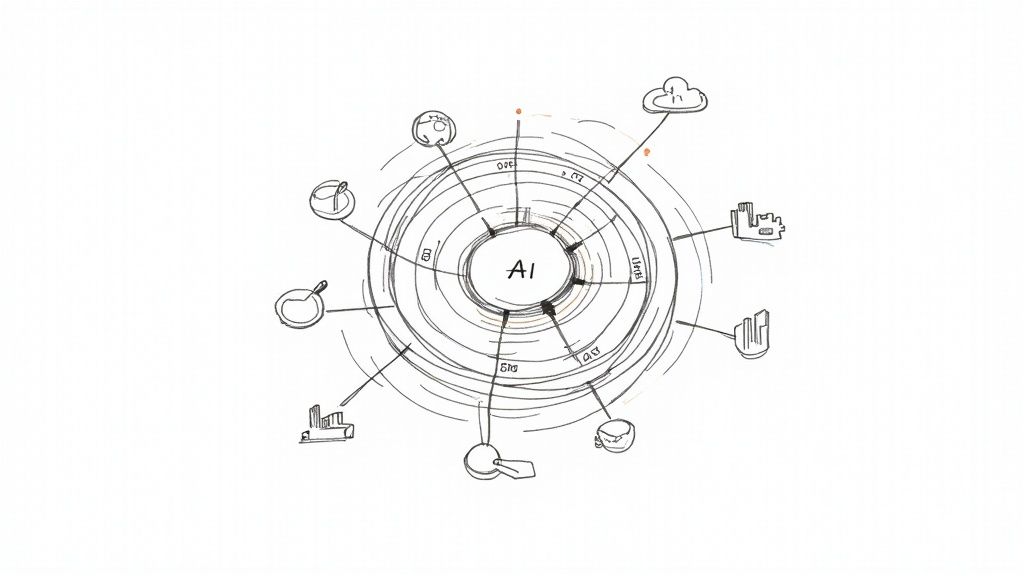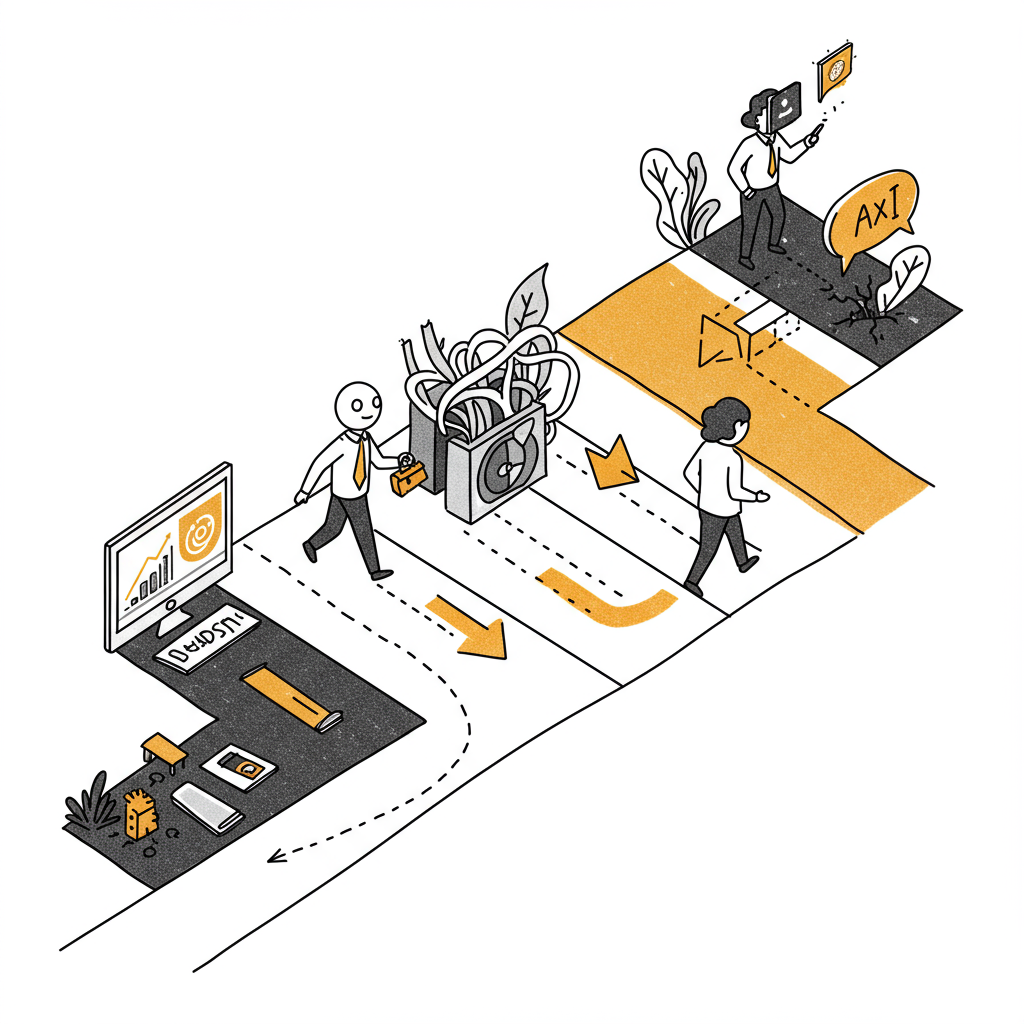AI Strategy Co-Creation for Modern Business
Unlock business growth with AI strategy co-creation. Learn collaborative methods from industry experts to build an AI roadmap that delivers real results.
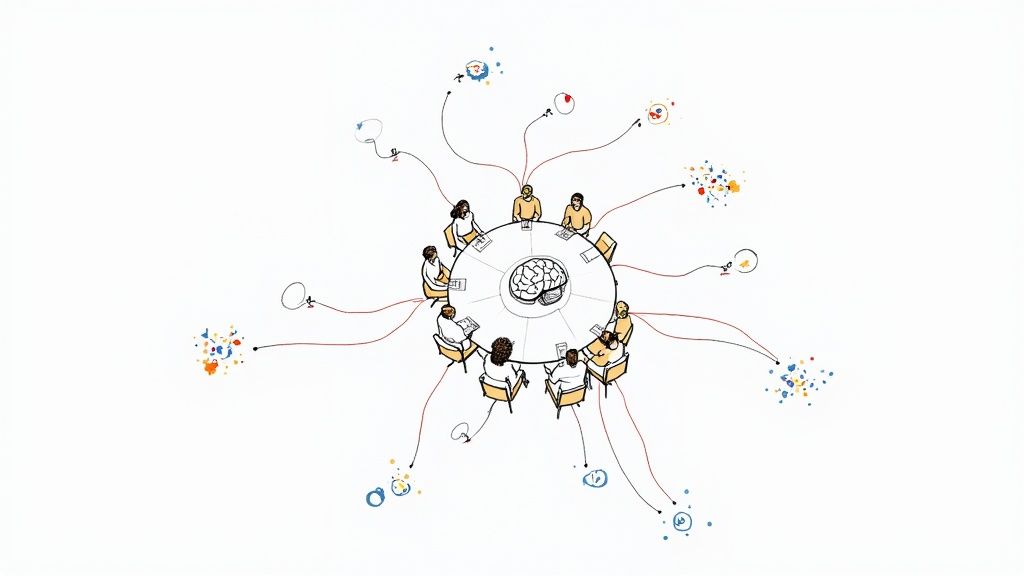
Co-creating an AI strategy simply means bringing everyone to the table to build your company’s roadmap.It’s about getting your technical experts, data scientists, business leaders, and even your front-line employees in the same room (virtual or otherwise). The goal is to hammer out a plan that’s not only technically sound but also practical, widely supported, and actually solves real-world business problems.
Why Collaborative AI Strategy Is No Longer Optional
Think back to how major decisions used to be made. Big strategic moves, especially the technical ones, were often cooked up in a boardroom or a locked-down IT department. This top-down approach had a fatal flaw: it frequently produced AI projects that, while brilliant on paper, completely missed the mark in solving actual business pain points or getting any traction with the teams supposed to use them.
This siloed thinking just doesn't work anymore. It ignores the most powerful asset you have – the collective intelligence of your people.
A successful AI journey isn't just about deploying the fanciest algorithms. It's about building a shared vision. When you invite different voices into the conversation, you get a much richer picture. For example, your sales team knows exactly what makes customers tick, and your operations staff can pinpoint the daily workflow headaches that are ripe for an AI solution. This is where true AI co creation really shines; it connects the dots between these different worlds.
Unlocking Collective Intelligence
At its core, this collaborative model is about de-risking your AI investments. By getting multiple departments involved from day one, you spot potential roadblocks early, uncover far more relevant opportunities, and build genuine buy-in across the organisation. It’s how you ensure the solutions you build are not just tech for tech's sake, but are practical, user-friendly, and set up for adoption from the start.
This shift towards collaborative planning has a direct, measurable impact. For Germany's economy alone, embracing AI is projected to add nearly 3% to annual market growth and boost labour productivity by an incredible 29% by 2035. If you're interested in the numbers, you can learn more about these economic projections.
The data speaks for itself. The proof is in the results that organisations are seeing right now.

As you can see, the benefits are compelling. Nearly half of organisations are already using this model, and they’re seeing significant ROI improvements in as little as six months.
To truly appreciate the shift, it helps to see the two approaches side-by-side.
Collaborative vs. Traditional AI Strategy
| Aspect | Traditional (Siloed) Approach | Collaborative (Co-Creation) Approach |
|---|---|---|
| Decision-Making | Top-down, made by a small group of executives or IT leaders. | Inclusive, involving cross-functional teams and stakeholders. |
| Problem Identification | Based on high-level assumptions, often disconnected from daily work. | Grounded in real-world pain points identified by front-line teams. |
| Buy-In & Adoption | Often low, as teams feel solutions are imposed on them. | High, because teams have a sense of ownership and co-created the solution. |
| Risk | High risk of project failure due to poor alignment and low adoption. | Lower risk, as potential issues are identified and addressed early. |
| Innovation | Limited to the ideas of a few people. | Fosters broad innovation by tapping into collective intelligence. |
This table makes it clear: the collaborative approach isn't just a "nice-to-have"—it’s a fundamentally better way to build a strategy that works.
A Modern Necessity for Growth
In the end, sticking to the old way is a strategic risk you can't afford to take. The companies that will pull ahead are the ones that figure out how to tap into the knowledge of their entire workforce. This isn't just some passing trend; it’s a core part of being an agile, modern business. It’s the prerequisite for creating resilient, effective, and truly impactful AI solutions that give you a real competitive edge.
Building Your Cross-Functional AI Team
Let's be clear: a powerful AI strategy is built by people, not algorithms. Putting together the right cross-functional team is arguably the most critical part of this whole process. This isn't just about filling seats with predictable job titles. It's about carefully curating a group of individuals who have the right mindsets and a mix of skills to drive actual business results.
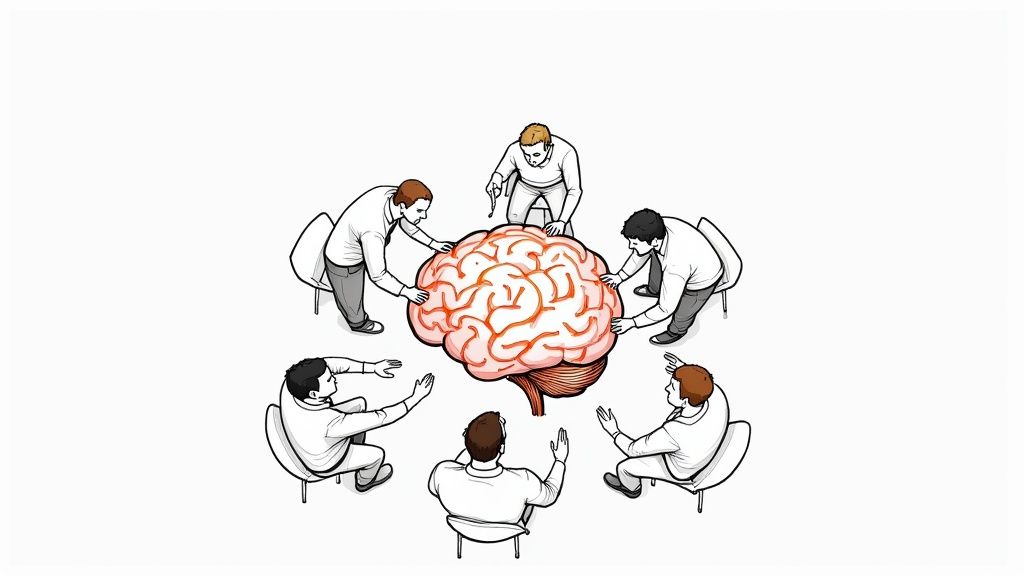
From my experience, the most successful teams are those that blend deep technical knowledge with sharp business acumen. You need data scientists who can talk profit and loss, and marketing leads who grasp the real potential of machine learning. It's this synergy that turns abstract ideas into concrete, valuable solutions that solve genuine customer problems and fit into how your business actually works.
Who Should Be on Your AI Co-Creation Team?
When you're looking for team members, don't just look at their CVs. Look for people who are naturally curious, genuinely collaborative, and obsessed with solving problems. Your ideal team will have a mix of roles, with each person bringing a unique and vital perspective to the conversation.
Here’s a look at the key players you'll want to get on board:
- The Executive Sponsor: This is a senior leader who will champion the project. Their job isn’t just to sign off on the budget; they're there to clear roadblocks, rally for resources, and make sure the team’s work stays locked in with the company's biggest goals.
- Business Unit Leaders: These are the folks who own the P&L and live and breathe the daily operational challenges. You absolutely need representatives from sales, marketing, operations, and customer service to pinpoint where AI can make the biggest difference.
- Technical Experts: This crew includes your data scientists, AI/ML engineers, and IT architects. They’re the ones who will figure out if an idea is technically possible, handle the data infrastructure, and actually build the AI models.
- Subject Matter Experts (SMEs): These are your frontline employees—the people who will be using the AI tools every day. Their hands-on knowledge is invaluable for making sure the final product is practical, user-friendly, and solves the right problem.
- The Project Manager or Facilitator: This person is the glue that holds everything together. They organise the workshops, manage the timelines, and ensure communication flows smoothly between everyone, keeping the collaborative energy from fizzling out.
Your first big hurdle is getting buy-in from these different department heads. Don't frame this as just another tech project. Position it as a business initiative that will directly help their teams hit their targets.
I’ve seen this go wrong before. A common mistake is building a team that's all tech. While you need their skills, a lack of business context often leads to solutions that are technically brilliant but commercially useless. The real magic happens where technical possibility meets a genuine business need.
Structuring the Team for Success
Once you have your people, they need a clear structure to work effectively. Define everyone's roles and responsibilities right from the start to avoid confusion and ensure everyone is accountable. You also need to set a regular communication cadence—maybe it's weekly stand-ups, monthly steering committee meetings, or just a dedicated chat channel.
A structured approach like this encourages the open dialogue that is so central to co-creation. For more ideas on assembling high-performing groups, you can see the principles that guide our expert team in delivering impactful AI strategies. The goal is to create an environment where a sales leader feels just as comfortable throwing out an idea as a data scientist does.
Building a Shared Vision and Setting Clear Goals
Once you’ve brought your cross-functional AI team together, the very first thing on the agenda is to forge a common direction. You can have the most brilliant people in a room, but without a shared purpose, you’ll find them pulling in different directions. That’s how projects stall and brilliant ideas fizzle out. We need to move past fuzzy goals like "let's do AI" and get down to specific, measurable objectives that tie directly back to our core business KPIs.
This alignment is the very soul of AI strategy co-creation. It all starts with getting everyone to agree on what success actually looks like. I'm not just talking about financial targets; this is about pinpointing the real business problems you're trying to crack and the tangible improvements you expect to see on the ground. This foundational work gets the entire organisation moving as one.
From Big Ideas to Concrete Actions
One of the best ways I’ve seen to get this started is with a series of well-run workshops. These aren't your average, run-of-the-mill meetings. The goal here is to create a space where people from all corners of the business feel they can speak up—sharing their unique challenges, perspectives, and hopes for what AI can do for them. It’s all about bridging the gap between what's technically possible and what the business genuinely needs.
Think about it: your sales team might be desperate for an AI that can flag customers who are about to leave, while the operations team is focused on using AI to untangle supply chain knots. A workshop is where these different priorities can be aired, debated, and ultimately mapped against the company’s bigger strategic goals. This kind of conversation stops teams from building things in isolation and ensures your AI projects get the buy-in they need to make a real difference.
It’s so easy to jump into brainstorming solutions before you've even fully understood the problem you're trying to solve. A solid AI strategy framework gives you the structure you need, guiding your team through a deliberate process of setting goals and making sure crucial things like ethical principles are baked in from day one.
This structured approach is what turns a broad idea like "improve customer service" into a sharp, actionable goal. For example, it becomes: "Deploy an AI-powered support assistant to cut our average customer ticket resolution time by 25% within the next six months." That's the kind of clarity you need to track progress and prove the value of your work.
Weaving Responsibility into Your AI DNA
Crafting a shared vision also means making ethics and responsibility a core part of your strategy, not just a box-ticking exercise at the end. We can actually take a page from how some countries are handling this. Germany's national AI strategy, for instance, pulls in multiple government ministries to ensure AI development serves the common good and benefits all of society. Taking inspiration from this model of co-creation helps build a responsible AI future from the ground up. You can discover more about Germany’s approach to AI policy to see how they integrate public and private actors.
When you make ethical considerations a central part of these early goal-setting discussions, you build a strategy that isn’t just powerful, but also trustworthy and built to last. As we also covered in our AI adoption guide, this collaborative goal-setting is what truly sets an organisation up for success.
Turning Collaborative Ideas Into an Actionable Roadmap
Energetic workshops and shared goals are a fantastic starting point, but let's be honest—they're just that: a start. The real test is turning all that collective energy into a concrete, value-driven action plan. This is the moment your AI strategy co-creation efforts shift from talk to action, creating a clear path that your entire team can actually get behind.
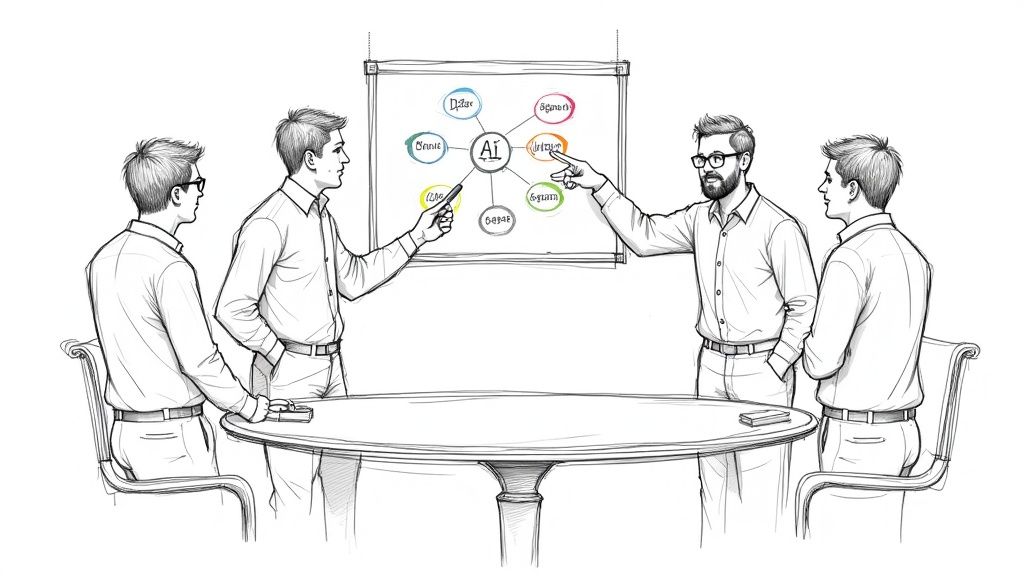
It all begins with structured ideation. Simply asking, "What should we do with AI?" is far too broad and often leads nowhere. You need a focused way to generate, capture, and then refine ideas. This is how you ensure the momentum from your vision-setting sessions translates into a portfolio of projects with real impact.
From Brainstorm to a Prioritised Portfolio
Running effective ideation sessions is a skill in itself. It's about creating an atmosphere where everyone, from the marketing assistant to the senior engineer, feels comfortable contributing. One powerful technique I've seen work well is using a dedicated AI requirements analysis generator. Tools like this help teams capture their initial thoughts in a structured format, quickly turning a jumble of ideas into clearly defined project outlines.
Once you have a long list of potential projects, the next crucial step is to filter them down. Not all ideas are created equal, and chasing too many at once is a classic recipe for failure. This is where a collaborative evaluation process becomes essential.
Get your cross-functional team together to weigh each potential project against a few critical criteria:
- Strategic Alignment: Does this project directly support the core business goals we all agreed on earlier?
- Potential ROI: What’s the likely financial or operational return? Can we build a solid business case for it?
- Technical Feasibility: Do we realistically have the data, tech, and skills to pull this off, or are we just dreaming?
- Business Impact: How much will this project actually move the needle on a specific process, customer experience, or revenue stream?
This evaluation can't happen in a silo. I always recommend using a shared scoring system in a workshop setting. It allows the team to openly debate the merits of each idea, which naturally fosters a sense of shared ownership over the final, prioritised list. This collaborative filtering is a core principle of our AI strategy consulting approach.
Building a Dynamic and Realistic Roadmap
With your high-impact initiatives selected, it's time to build the roadmap. A common mistake I see companies make is creating a static, five-year plan that ends up gathering dust on a shelf. A truly effective AI roadmap is a living document—it’s dynamic, flexible, and designed to deliver value quickly.
The best approach? Sequence your projects to secure some early victories. Identify a few "quick win" projects that are relatively low-effort but have a visible impact. Successfully delivering these builds crucial momentum, proves the value of AI to leadership, and energises the team for the tougher, long-term transformations that lie ahead.
A great roadmap tells a story. It should clearly show how you'll move from foundational projects that build your capabilities to more advanced initiatives that create a true competitive advantage. This narrative helps keep everyone aligned and focused on the journey.
To make this tangible, ground your roadmap in real-world use cases. Instead of using abstract project names, frame them around the outcomes they'll deliver. For example, "Implement Customer Churn Prediction Model" is far more compelling and understandable to everyone than something vague like "Project Phoenix."
A well-organised roadmap might look something like this:
| Phase | Timeframe | Focus Area | Key Projects |
|---|---|---|---|
| Phase 1: Foundation | 0-6 Months | Quick Wins & Data Readiness | - Automate internal reporting - Centralise customer data |
| Phase 2: Optimisation | 6-18 Months | Core Process Improvement | - AI-powered inventory forecasting - Predictive maintenance for machinery |
| Phase 3: Transformation | 18+ Months | New Business Models | - Personalised product recommendations - Develop new AI-driven services |
This phased approach, guided by a solid AI strategy framework, ensures you are building capabilities progressively. You can even use an AI Strategy consulting tool to help model different scenarios and visualise what your roadmap could look like. Remember, the entire goal of AI co creation is to build a plan that the business not only understands but is genuinely excited to execute. And if you need a hand, our expert team is always ready to help shape a roadmap that truly delivers.
Maintaining Momentum with Smart Governance
An energetic workshop can feel like a massive win, but let's be honest—the real work in AI strategy co-creation begins the day after everyone leaves the room. That initial burst of enthusiasm is brilliant, but it's consistent, thoughtful governance that prevents a great plan from collecting dust on a shelf. Co-creation isn't a one-and-done event; it's an ongoing commitment that needs a solid framework to keep it alive and evolving with your business.
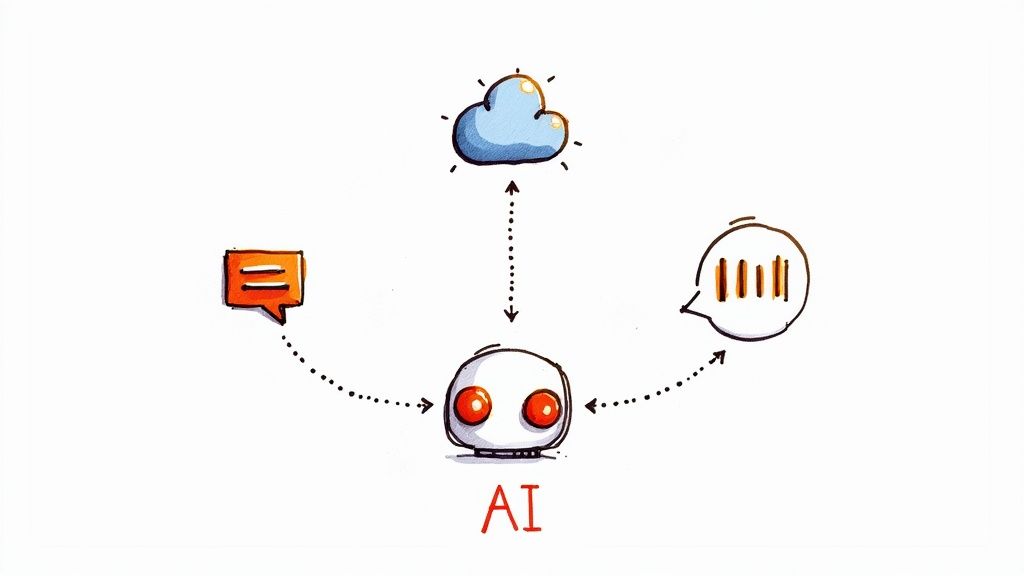
What this really means is setting up a clear governance structure that perfectly balances speed with sensible oversight. You're aiming for a system that empowers your team to act decisively on AI initiatives without going off-piste strategically or stumbling into unnecessary risks. This is a core part of how we approach our AI strategy consulting—we focus on making sure your plan remains a living, breathing document.
Establishing Agile Governance
Forget the old-school, bureaucratic review boards that seem designed to slow everything down. For AI, your governance needs to be nimble and geared towards enabling progress, not putting up roadblocks. It all comes down to defining how decisions get made, how you measure progress, and who is ultimately accountable for each piece of the puzzle.
A model I've seen work time and again involves a small, central AI steering committee. Often, this group includes the same cross-functional leaders from your initial workshop, and they meet regularly. Their job isn't to micromanage every detail. It's to:
- Review Progress: How are projects tracking against the roadmap we all agreed on?
- Remove Blockers: What organisational hurdles are slowing teams down, and how can we clear the path?
- Re-prioritise Initiatives: What have we learned? Do we need to adjust our focus based on new insights or shifting business needs?
- Champion Successes: Make sure every win, big or small, is celebrated and communicated across the entire organisation.
This approach keeps your AI efforts firmly connected to real business value while preserving the flexibility that genuine innovation demands.
A common trap I see companies fall into is treating governance purely as a risk-management chore. Smart governance is just as much about nurturing momentum. It creates the psychological safety for teams to experiment, learn from what doesn't work, and keep pushing forward, knowing they have the organisation's backing.
Creating Continuous Feedback Loops
For your strategy to stay relevant, you have to keep feeding it with fresh information from the front lines of both the business and the technology. This means building intentional feedback mechanisms into your rhythm. You can set up these ongoing conversations through structured sessions, something we dive into in our guide on running an effective AI strategy workshop.
Think about implementing regular, lightweight check-ins. These are opportunities for project teams to share what’s clicking and what's causing friction. It's crucial that these are blame-free zones focused on solving problems together.
This simple practice helps build a culture where celebrating small victories and learning from setbacks becomes second nature. It keeps the energy high and constantly demonstrates the value of your AI efforts back to the business, ensuring everyone stays informed, engaged, and motivated for the journey ahead.
Answering the Tough Questions About AI Co-Creation
Even when everyone's on board with the idea of working together on AI, you're bound to hit some tricky spots. Let's walk through a few of the common questions and roadblocks I've seen teams run into. Getting these right can make all the difference.
It’s almost inevitable: friction between your technical folks and your business teams. The engineers are focused on the tech, while the business side is thinking about market impact. The trick is to get them to stop talking about their own priorities and start focusing on the shared business value they can create together.
Well-run workshops and crystal-clear success metrics are your best friends here. You have to constantly bring the conversation back to the common goal, bridging that gap between departments.
How Do We Get Leadership to Back This Approach?
Getting the C-suite to support a collaborative model can feel like an uphill battle. Your best bet is to build a rock-solid business case. Don't just talk about collaboration; frame your proposal around tangible outcomes like reduced project risk, better employee adoption, and a direct line to hitting major company goals.
Often, the most powerful move is to start small. Run a pilot project that you know can deliver a quick, visible win.
Pro Tip: Nothing convinces leadership like results. A successful pilot project provides the hard evidence they need to greenlight a broader AI co-creation initiative.
What’s the Magic Number for a Co-Creation Team?
Team size is a delicate balance. Based on what I've seen work time and again, a core group of 5 to 9 dedicated members is the sweet spot.
This size keeps you nimble and allows for quick decisions, but it’s still large enough to bring in different perspectives from across the business. You can then have a wider circle of subject-matter experts you can pull in whenever their specific knowledge is needed.
Are There Specific Tools That Actually Help With This?
Absolutely. While general-purpose tools like Miro or Microsoft Teams are great for brainstorming sessions and keeping communication flowing, they aren't built for this specific task.
Specialised platforms can make the whole process much smoother. For example, our own AI Strategy consulting tool was designed from the ground up to guide teams through this exact journey. And if you feel you need more hands-on support, our expert team has been in the trenches and is always ready to help you nail your strategy.
Ready to turn those collaborative ideas into a powerful, actionable strategy? Ekipa's AI strategy consulting platform helps you build a tailored AI roadmap without the high cost of traditional consultants. Get your AI strategy now. If you'd like to learn more about the people behind our approach, meet our expert team.


